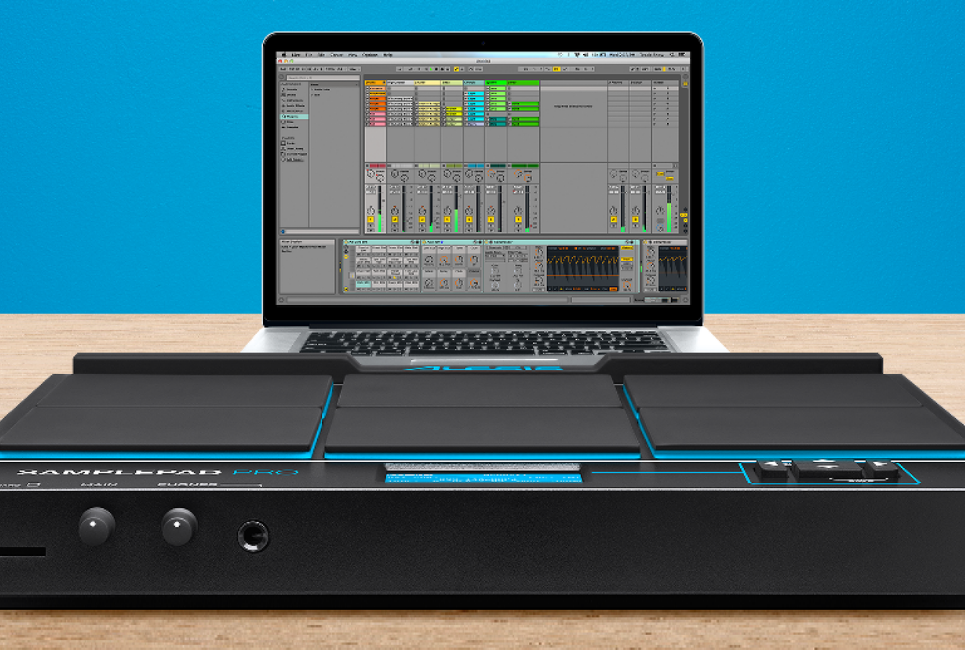The Alesis SamplePad Pro may be a very enticing product at first. It’s about half the price of the other popular sample pads on the market, and it offers all of the same features. When looking at it through that lens, it looks fairly attractive.
However, it has a few issues that make the lower price point understandable. This review will see how feasible the Alesis SamplePad Pro is to use in both practice spaces and professional settings. I’ll also give you a quick guide and what sample pads are and how to use them.
What is a Sample Pad?
A sample pad is an electronic device that allows you to play electronic sounds by hitting pads that trigger them. Another name for a sample pad is an electronic drum pad. Typically, sample pads have multiple trigger pads on them. However, you get some single pads that you can buy, such as the Roland SPD-ONE.
The features don’t just stop at triggering electronic sounds, though. Depending on which sample pads you’re looking at, they often have the power to do a lot more such as running click tracks and backing tracks for a band in a live setting.
Sample Pads in Drum Setups
Drummers most commonly use sample pads in modern settings. A sample pad will be mounted somewhere in the drum kit setup, and a drummer will use their sticks to hit the pads on the device.
When electronics are mixed with acoustic drums, it’s commonly referred to as hybrid drumming. Having a sample pad in the mix is one of the easiest ways of incorporating a hybrid setup. It allows you to get percussive sounds that an acoustic kit wouldn’t allow. The most common sounds would be hand claps, shaker patterns, and any sort of melodic synth sounds.
With the sample pad being an electronic device, you need to plug it into a sound source. If you’re practicing at home, it would need to plug into a speaker near the kit. In live gig settings, the sample pad would run through to a sound desk where a sound engineer would then play it through the PA system.
What to Look for in a Sample Pad
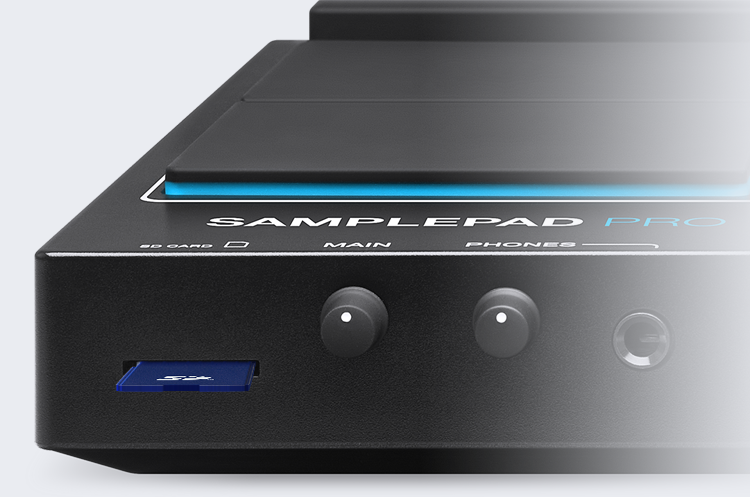
Not all sample pads are made the same way. Different brands offer different things. So, you need to weigh up everything on offer to see which sample pad will be the best option. It’s good to compare the products available to make an informed buying decision.
Here’s what you should be looking for when buying a sample pad:
- Sound quality
- Construction quality
- How the pad will perform in live settings
- Price
If the sample pad ticks all the boxes for you when looking through that criteria, it’s going to be an excellent buy. If it doesn’t fulfill a few expectations, you’ll have to determine if you can live with that. Otherwise, you’ll need to find a better option.
With all that being said, let’s move on to the Alesis SamplePad Pro review.
Alesis Sample Pad Pro Review
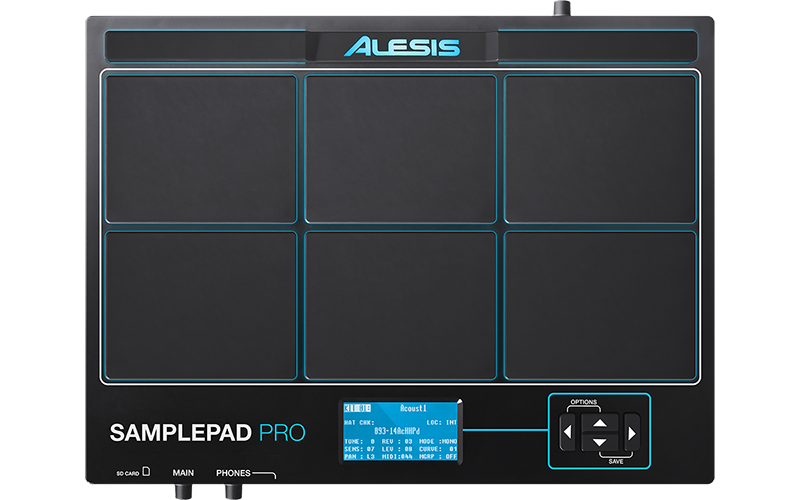
The Alesis SamplePad Pro is one of Alesis’s more affordable electronic drum pads. It sits in between the SamplePad 4 and the Strike MultiPad. The whole idea behind it is that it’s more accessible to people buying their first drum pads.
My favorite thing about the pad is how it looks. It’s covered in blue lights that shine fairly brightly, allowing you to see everything in dark areas. There are several excellent features, so let’s check those out.
Key Features
- Eight single-zone pads on the surface
- Space for two additional inputs
- Ten preset kits with over 200 available sample sounds
- Option to load your sample sounds
Sound Quality
While I’ve never been the biggest fan of the sounds that come on Alesis electronic drum modules, I’m fairly impressed with the sounds on the Sample Pad Pro. They’re the same sample sounds, but the sample pad doesn’t need to have the same response that I’d expect a drum set to have. This makes the sounds a lot more palatable.
You get a wide range of preloaded sample sounds, ranging from drum kits to weird and wonderful chord progressions. If you were to simply use what’s on offer here, you’d find yourself having loads of fun with all the different preset kits.
Construction
The physical construction of the pad is quite sturdy. It feels very secure when playing, and you could hit the pad quite hard while it’s mounted without worrying about it getting damaged or falling off the mount.
The pads, on the other hand, have a few issues. You get eight pads on the surface. Six of them are set up in two lines, while two of the pads are on the top shoulders of the device. These top pads are a lot thinner.
The top pads are a big weak point as they often have crosstalk and sensitivity issues. If I were to use the SamplePad Pro in a professional setting, I’d stay clear of the shoulder pads as they’re not reliable enough for me.
All of the pads aren’t as sensitive as those on higher-priced models. This won’t be an issue if you’re simply looking to play single sounds here and there. It will become a bit of a problem if you want to play complex patterns on them. Double strokes and other fast rudiments don’t feel amazing to play.
Performance
I’ve already touched on how I wouldn’t use the shoulder pads for live performances. However, I wouldn’t use this pad if I had custom samples. Here lies the biggest problem with the Alesis SamplePad Pro.
It’s fantastic that you can load in your sample sounds, but it can take up to 30 seconds for the custom kit to load when you switch to it on the pad. If you had multiple custom kits to use for different songs in a gig, it would be unpractical as the wait between switches would ruin the momentum of your show.
If you want to use this pad for live performances, I’d only say that it’s a good idea if you use the onboard sounds and stay clear of the two pads at the top.
Price
The price is what will sell this pad for most people. Sample pads are incredibly expensive, especially if you’re not looking to use the features to their full extent. So, it could be a good idea to only spend between $300 and $400 on the Alesis SamplePad Pro if you want something cheaper.
Just note that you’re paying for a lower-quality sample pad. The concerns I highlighted above are why this pad costs a lot less than the industry-standard sample pads.
Pros and Cons
Pros
- Blue LED lights make the pad look very cool
- The onboard sample sounds are great
- The body is well-built
- Very affordable and accessible to people not looking to spend a lot on a sample pad
Cons
- Not ideal for live performances
Final Verdict
From looking at all the pros and cons of the Alesis SamplePad Pro, it’s quite clear that this isn’t the best option on the market to get. I’m a big fan of the sounds and the visual aesthetic of it, but I wouldn’t risk using this pad at a gig.
It would be a suitable pad for a home setup. However, I’ve found that having something like this in your practice room gets a bit boring over time. I know so many drummers who bought these pads thinking they’ll heavily utilize them only to neglect them after a few years.
The best way to get extended use out of a sample pad is to use it for live gigs, and I wouldn’t recommend the SamplePad Pro for that. It might be passable if you’re just using the onboard sounds, but a sample pad’s strength lies in the ability to use your own custom sounds.
So, I don’t think this is a pad that you should buy. Now, let’s look at some pads that I will happily recommend to anyone.
Alternatives
Roland SPD-SX

The Roland SPD-SX is the industry-standard sample pad. This is the pad you’ll see all the professional drummers using on massive stages and live TV performances. It holds the gold standard that every other pad tries to live up to. So, this is the best pad to get if you want the best possible option.
The pads on the device are incredibly reactive and sensitive, allowing you to play intricate patterns with varying dynamics. You could hook up a bass drum trigger to the SPD-SX to have a standalone compact electronic drum kit for really small venues.
While the SPD-SX comes with a few preset kits, it has way more space for you to import your own. It also has multiple sound editing tools onboard, allowing you to edit those sounds to an impressive extent.
I know a few bands who run their live sets directly from an SPD-SX. It’s powerful enough to run backing tracks, click tracks, and simultaneously act as an electronic sound source. I remember sitting with one of these for hours, figuring out a few things. Watching a few YouTube videos helped with the learning process, but it will still take a fair amount of time to get used to.
If you’re a working drummer, there’s no better option than the Roland SPD-SX.
Pros
- Industry-standard sampling pad
- Plenty of space for custom samples
- Extensive sound editing tools
Cons
- Steep learning curve
Yamaha DTX-MULTI 12
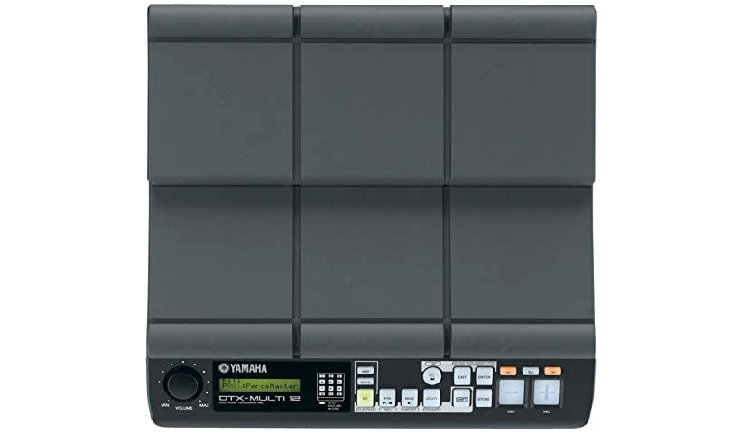
The Yamaha DTX-MULTI 12 is the main competitor to the Roland SPD-SX. While the Yamaha pad has the option of loading custom sounds, it has an incredibly impressive library of over 1200 onboard sounds to play with.
I’ve always told people to consider getting this pad over the SPD-SX if they’re not interested in creating and loading their own samples. The Yamaha pad is a powerful machine with 12 pads to play on. They’re sensitive enough to play with your fingers, so you could use the pad in a percussion rig if you wanted to.
It also has an extensive number of sound editing tools as well as a built-in sequencer. The sequencer is my favorite aspect of this sample pad. You can create loops and keep yourself entertained for hours by playing drums to the loops you’ve made.
You can control a lot of the functions of the pad with an app that Yamaha has integrated with it. However, the app isn’t well optimized, so I found that it’s better to do everything manually with the onboard interface.
Pros
- 12 pads
- Over 1200 onboard sounds
- A bit more affordable than the Roland SPD-SX
Cons
- The integrated app is badly optimized
Alesis Strike MultiPad

The Alesis Strike MultiPad takes everything from the SamplePad Pro and improves on it. If you have the money for it, I’d suggest getting this over the SamplePad Pro if you want to stick with an Alesis product.
It has nine pads, three of them being smaller ones at the top of the surface. Like the SamplePad Pro, this device has neon lights that spectacularly illuminate the pads. However, the lights are multi-colored on this one, making identifying pads much easier.
The pad has 32GB of onboard memory, letting you load in a fair amount of your own sample sounds. 6GB of that space is filled with high-quality sounds from Alesis. You get all of the same samples from the MultiPad with a lot more added.
While this pad isn’t as popular as the Roland or Yamaha ones, I think it’s a strong contender. It just doesn’t have the same extensive sound editing features.
Pros
- Neon LED lights are fantastic
- Easy to distinguish between different pads
- Large space for custom samples
- Improved version of the SamplePad Pro
Cons
- It doesn’t have as many sound editing tools as the Roland or Yamaha pads
Nord Modeling Percussion Synthesizer Multi-Pad

The Nord Modeling Percussion Synthesizer is my wildcard pick for this alternate option list. It’s the most expensive sampling pad on the market, so it’s not a viable option for everyone. However, it’s arguably the best sounding pad on the market.
Nord is a company that specializes in creating high-quality electronic instruments. They’re most famous for their Nord Stage keyboards. If you’ve ever seen or played one of those, just imagine all the qualities from that transferring over to a drum pad. That’s what you get here.
You only have six pads to play on, but you get a comprehensive set of sound editing tools. This allows you to get the best sounds possible when you sit and work on them.
It’s not an easy device to learn to use, but it’s incredibly rewarding once you know how to navigate through it and create some world-class sample sounds.
Pros
- High-quality sounds from Nord
- Hugely comprehensive sound editing tools
- Caters to audiophiles and drummers who want pristine sounds
Cons
- Most expensive sampling pad on the market
FAQs
Answer: Drummers are the main people who use sample pads. Typically, a sample pad will be placed near a drum kit for a drummer to trigger sounds. It needs to be placed close enough for the drummer to hit all the pads with their drum sticks.
However, sample pads aren’t limited to that use. You could use a sample pad to run tracks for a one-man show, or you could use one as a makeshift electronic drum set. Having the ability to load in your own samples expands the possibilities of what you can do with a sample pad.
A sports team could even use a sample pad for non-music purposes, such as triggering sounds for team drills.
Answer: Roland is the most popular sample pad brand. Roland sits at the top of the market for everything related to electronic percussion. Their products have been the industry standard for decades, with the Roland SPD-SX being the current leading sample pad.
Alesis and Yamaha are also fantastic brands that offer top-quality sample pads. Nord also has the Modeling Percussion Synthesizer, which is a great pad.
The other sample pads available on the market from competing brands are lower-quality, meaning those brands aren’t as popular.
Answer: The companies that make the sample pads also make mounts and stands for them. The mount that connects to the bottom of the pad will typically come with the pad when you purchase it. However, the stand will usually need to be purchased separately.
Any cymbal stand will do the trick if you have a spare one. You’d just need to remove the top part that has the cymbal arm. Make sure the stand is double-braced and sturdy; otherwise, it won’t support the weight of a sample pad.
Answer: Alesis have carved a niche in the drum market where they produce lower-quality and more affordable products at a larger scale. Electronic drum kits from Alesis are often the best options for beginners compared to the more expensive products from Roland and Yamaha.
The Alesis Nitro Mesh is arguably one of the best electronic drum kits out there for someone looking to start playing the drums. Many of their products share a similar reputation.
The only Alesis product I can think of that isn’t cheaper than the competing products in a similar category is the Alesis Strike MultiPad.
Conclusion
The Alesis SamplePad Pro is a decent pad to get if you’re on a tight budget. However, there are four alternative sample pads, and any of them would be a better buy. The problem is that they’re all about double the price.
So, if you have the patience to wait and save enough money for one of them, I suggest you go down that route. If not, just know that the Alesis SamplePad Pro isn’t the ideal sampling pad for live gigging.
For more readings on drum gear, check out the following articles:
